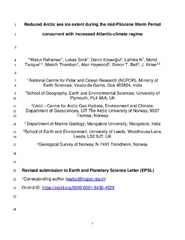| dc.contributor.author | Rahaman, Waliur | |
| dc.contributor.author | Smik, Lukas | |
| dc.contributor.author | Köseoğlu, Denizcan | |
| dc.contributor.author | Lathika, N. | |
| dc.contributor.author | Tarique, Mohd | |
| dc.contributor.author | Thamban, Meloth | |
| dc.contributor.author | Haywood, Alan | |
| dc.contributor.author | Belt, Simon T. | |
| dc.contributor.author | Knies, Jochen | |
| dc.date.accessioned | 2020-09-05T13:26:13Z | |
| dc.date.available | 2020-09-05T13:26:13Z | |
| dc.date.issued | 2020-09-01 | |
| dc.description.abstract | Quantifying the contribution of poleward oceanic heat transport to the Arctic Ocean is important for making future sea ice and climate predictions. To highlight its potential importance in a warmer world, we present a new record of water-mass exchange between the Atlantic and the Arctic Oceans using the authigenic neodymium isotopic composition of marine sediments from the Fram Strait during the past ∼3.4 to 2.6 Ma. In this study, we target the mid-Pliocene Warm Period (mPWP: 3.264–3.025 Ma) of the Pliocene epoch, the most recent geological analogue for future climate change. We complement our semi-quantitative water mass exchange reconstruction with estimates of spring sea ice concentration based on source-specific biomarkers. Our estimates of volume transport of warm waters into the Arctic Ocean suggest long-term secular changes from the lowest during the Marine Isotope Stage M2 “glacial” (3.312–3.264 Ma), to near complete “Atlantification” of the Eurasian sector of the Arctic Ocean during the mPWP. Orbital forcing is found to be the dominant controlling factor for modulating northward volume transport of Atlantic-derived water masses, with an associated reduction in Arctic spring sea ice concentration of ∼30–35%. Current generation models often produce diverging results, however, and have not yet been validated against proxy data in northern high latitude settings during the mPWP. Our new results of northward volume transport and sea ice extent therefore provide much needed input for validation of current generation models aimed at improving the robustness of future climate modeling in the Arctic. | en_US |
| dc.identifier.citation | Rahaman, Smik L, Köseoğlu D, Lathika, Tarique, Thamban M, Haywood AM, Belt ST, Knies J. Reduced Arctic sea ice extent during the mid-Pliocene Warm Period concurrent with increased Atlantic-climate regime. Earth and Planetary Science Letters. 2020;550 | en_US |
| dc.identifier.cristinID | FRIDAID 1826661 | |
| dc.identifier.doi | 10.1016/j.epsl.2020.116535 | |
| dc.identifier.issn | 0012-821X | |
| dc.identifier.issn | 1385-013X | |
| dc.identifier.uri | https://hdl.handle.net/10037/19225 | |
| dc.language.iso | eng | en_US |
| dc.publisher | Elsevier | en_US |
| dc.relation.journal | Earth and Planetary Science Letters | |
| dc.relation.projectID | info:eu-repo/grantAgreement/RCN/SFF/223259/Norway/Centre for Arctic Gas Hydrate, Environment and Climate/CAGE/ | en_US |
| dc.relation.projectID | info:eu-repo/grantAgreement/RCN/POLARPROG/248793/Norway/Pliocene Arctic Climate Teleconnections// | en_US |
| dc.rights.accessRights | openAccess | en_US |
| dc.rights.holder | Copyright 2020 Elsevier B.V. | en_US |
| dc.subject | VDP::Mathematics and natural science: 400::Geosciences: 450::Sedimentology: 456 | en_US |
| dc.subject | VDP::Matematikk og Naturvitenskap: 400::Geofag: 450::Sedimentologi: 456 | en_US |
| dc.subject | VDP::Mathematics and natural science: 400::Geosciences: 450::Oceanography: 452 | en_US |
| dc.subject | VDP::Matematikk og Naturvitenskap: 400::Geofag: 450::Oseanografi: 452 | en_US |
| dc.title | Reduced Arctic sea ice extent during the mid-Pliocene Warm Period concurrent with increased Atlantic-climate regime | en_US |
| dc.type.version | acceptedVersion | en_US |
| dc.type | Journal article | en_US |
| dc.type | Tidsskriftartikkel | en_US |
| dc.type | Peer reviewed | en_US |


 English
English norsk
norsk